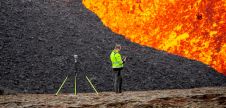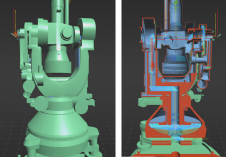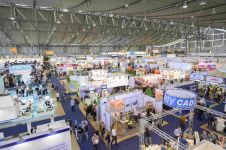International Lidar Mapping Forum
Rapidly Increasing Acquisition Capabilities
With over 580 registered delegates from 32 countries, forty international exhibitors and nearly a hundred abstracts submitted, the eighth annual International Lidar Mapping Forum(ILMF) reflected the growing importance of Lidar and was one of the most rewarding ILMF events ever.
Lidar manufacturers, service providers and users, including national and state government departments, presented a total of 34 technical papers. Jamie Wilder of Sanborn Map discussed trends in miniaturisation and software-controlled sensors, and recognised the need to establish national standards and control systems for metadata. He also considered threats posed by lower commercial rates and competition from other technologies such as IFSAR (Interferometric Synthetic Aperture Radar).
Standards
数码电子产品的小型化是选择ing Lidar, among other things by the increasing demand for Lidar in unmanned aerial vehicles (UAVs) for aerial mapping purposes. Scott Davis, of Vescent Photonics, illustrated this by demonstrating possibly the smallest 2D-scanner yet seen on a chip, based on liquid crystal technology. Combining two units, a 360-degree field of view from a 1-cm aperture can be achieved at very low cost. David Gisclair, technical director for the office of the Louisiana Oil Spill Co-ordinator, set out the need for national standards in dealing with multidimensional spatial metadata, both in formats and data-retrieval systems. Many speakers noted the rapidly increasing data-acquisition capabilities of Lidar scanners; they can now acquire up to 240,000 points per second, whereas only two years ago 100,000 was the limit, according to Peter Rieger of Riegl Laser Systems, Austria. Ron Roth of Leica Geosystems explained how now one or more other sensors, such as hyperspectral infrared or multispectral, could be routinely operated onboard with the Lidar scanner, and all data directly geo-referenced. This reduces costs and increases the efficiency and productivity of Lidar. Stephan Landtwing, of Swissphoto, showed how Lidar and a Vexcel digital camera could simultaneously acquire data, saving many days of flying time. Akira Kato, from the University of Washington, illustrated how combining RGB colours of image pixels with Lidar data enabled identification of tree species and their height.
Climate Change
Anders Ekelund, of Airborne Hydrography AB, Sweden, noted that whilst the original driver for bathymetric Lidar had come from the military need to hunt for submarines in shallow waters, the new driver is global warming. The rise of sea levels endangers coastal and estuarine regions; an average 1m rise results in up to 100m of coastal erosion. Mapping coastal zones was, he said, a task for which Lidar was well suited. The HawkEye system, for example, combines 4,000 bathymetric soundings with 64,000 topographic soundings and one digital image per second. Although water clarity does limit depth of penetration, bathymetric Lidar systems can penetrate up to a water depth of 70m.
Lidar Basics
This conference saw the advent of ‘Basics to Lidar’ Workshops, a series of teach-ins open to all delegates and aimed at increasing awareness and understanding of Lidar and illustrating its benefits and applications. Presentations were delivered by a number of speakers: Ron Roth of Leica Geosystems, Jim Green from Optech, Jim van Rens of Riegl USA, Lewis Graham from GeoCue Corporation, and Bill Emison of Merrick & Company. All the workshops were oversubscribed and the sessions enjoyed as much by the experienced people as by newcomers.
Exhibition
On the exhibition floor, full-service providers included Woolpert, Merrick, Fugro, Spectrum Mapping and Blom Aerofilms; the latter showing its combined topographic and bathymetric Lidar capabilities. First timer Tiltan Systems Engineering from Israel showed TLiD software solutions for automated processing of Lidar data. Airborne Hydrography of Sweden showed its dual-mode systems for hydrographic surveying. On the Riegl stand they were busy detailing echo-waveform digitisation in the new LMS-S560 system. GeoCue brought the key issue of processing massive amounts of data into focus, with its integrated end-to-end processing framework solutions. Production of DTMs, 3D-building models and visualisation suites were represented by Group SCE of India, QCoherent of the US and PCI Geomatics of Canada. To take Lidar sensors into the air one needs survey aircraft, the reason for Dynamic Aviation to be there.
Final Remarks
ILMF, held in Denver, Colorado from February 21st to 22nd 2008, was organised by Intelligent Exhibitions Ltd, chaired by Alastair MacDonald of TMS International Ltd, the other organising partner, and supported by the ASPRS (American Society forPhotogrammetry&Remote Sensing). On the opening night everyone enjoyed a reception buffet, and after the conference nearly forty hardy skiers and snowboarders were taken up into the snow-covered Rockies surrounding Denver: a fantastic day! The date and venue for ILMF 2009 have yet to be decided.
Make your inbox more interesting.Add some geo.
Keep abreast of news, developments and technological advancement in the geomatics industry.
Sign up for free
























